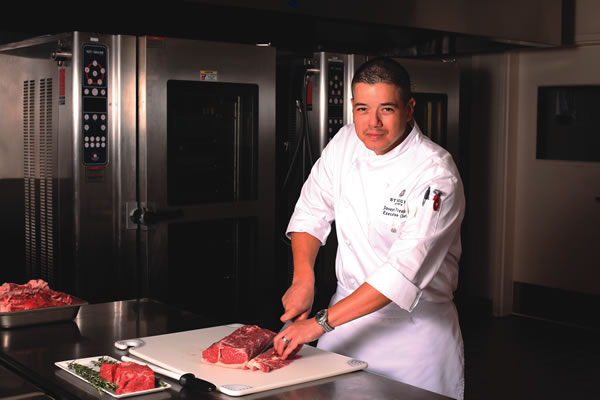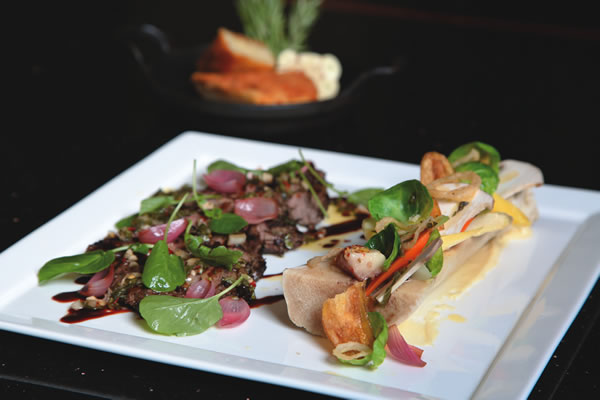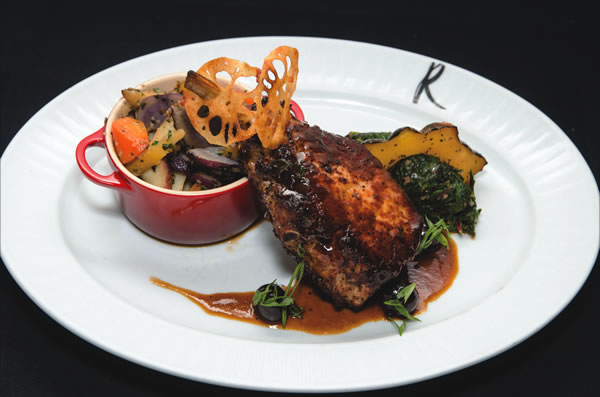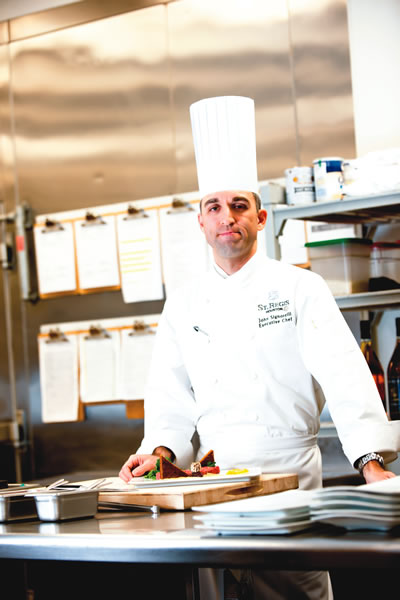There is much more behind the craft meats movement than mere taste.- By Rich Manning

 At its most basic level, the craft meats movement can be defined as a growing philosophy shared among smaller purveyors that reject the hormone and antibiotic-addled parlor tricks utilized by larger, mass-produced meat conglomerates in favor of raising beef, poultry, fish and game using traditionally organic and natural methods. However, this simple description, while handy, does not begin to the story of why this extension of the artisanal food mindset has emerged to arguably become the most indispensable culinary element deployed by chefs around the county, including the culinary talents that oversee the kitchens of the St. Regis Hotels & Resorts.
At its most basic level, the craft meats movement can be defined as a growing philosophy shared among smaller purveyors that reject the hormone and antibiotic-addled parlor tricks utilized by larger, mass-produced meat conglomerates in favor of raising beef, poultry, fish and game using traditionally organic and natural methods. However, this simple description, while handy, does not begin to the story of why this extension of the artisanal food mindset has emerged to arguably become the most indispensable culinary element deployed by chefs around the county, including the culinary talents that oversee the kitchens of the St. Regis Hotels & Resorts.
More Than Taste
As any self-respecting foodie will tell you, the taste of craft-raised meats is vastly superior to the products pumped out by their noncraft competition. And while the higher quality of flavors and textures that are readily found in craft-raised meats play a large role in their usage by St. Regis’ chefs, several other factors play critical roles in their appeal. Take health, for example; an element that stretches past typical dietary metrics.
“The health benefits of craft meats are not necessarily measured in fat or calories,” explains Joe Trevino, executive chef at The St. Regis Atlanta. “They are measured in knowing how your food sources respect the ingredients, thusly ensuring the product is as natural as possible. That said, there are some increased health benefits when animals are raised naturally, as their diets are focused on regional vegetation as opposed to processed corn and other biofeed methods.”
This natural feeding process is a crucial part of the movement, since it naturally translates into not absorbing the kind of chemicals, hormones and antibiotics that humans shouldn’t be consuming in the first place. “There are no artificial elements introduced to the meat,” says Rocio Varela, executive chef at The St. Regis Bahia Beach Resort. “Hence, there are no artificial elements trespassing the human body.”
Ethical concerns are also prominent factors within the movement. “When you put artificial hormones into an animal, they do not grow properly,” says Romuald Feger, executive chef at The St. Regis San Francisco. “If the animal was human, it would more or less be like a teenager trapped in an adult body. There is just something wrong about that.”
Knowledge is Power
Given its noble principles, it’s not all that surprising that the craft meats movement has been thoroughly embraced by chefs that strongly care about serving the best product possible. And really, it shouldn’t exactly be shocking that such passion has been matched by an increasingly sophisticated public.
Since the farm-to-table movement exploded onto the scene a few years ago, people have not only become more vigilant about what they put in their mouths but they also have developed a stronger desire to discover precisely where the food they consume comes from. If anything, the adherence to the craft meats movement has helped to show this type of culinary journey clearly.
“As a culture, we have become more and more aware of how all of our foods are being handled and have learned the importance of consuming as a whole,” says Frederic Castan, executive chef at The St. Regis Monarch Beach. “In turn, it’s only natural for our consumers to look for farmers and producers that meet these standards. And because craft meats taste better and give a better final product, it’s only natural that we would seek them out on our end, too.”
In some respects, this enhanced awareness has helped to strengthen the connection between the chef and the guest in ways that go beyond the preparation and enjoyment of a delicious meal.
“I have had guests thank me for using a certain meat before they actually order a dish that features it,” says Jordi Valles, executive chef at The St. Regis Bal Harbour Resort. “To me, that kind of intimate knowledge gives me a sense of pride, as it helps to remind me that I am part of a very important chain.”
The public’s growing familiarity of craft meats has ultimately turned some of the farms that promote the organic raising of animals into unlikely superstars. Some of the purveyors that are used by St. Regis chefs double as heavy hitters in this realm: Jidori Chicken, Brandt Beef, Berkshire Farms, Niman Ranch—all brands that tend to make the average foodie’s eyes light up upon seeing the names plastered on a menu. This may have seemed downright odd as little as five years ago, but the fact that some artisanal farms have become household names speaks highly of one of the craft meat movement’s strongest attributes.
“The idea of our guests knowing the names of some of the farms we work with demonstrates a direct conduit between the guest and the farm,” says John Signorelli, executive chef of The St. Regis Houston. “Ultimately, the use of craft meats allows for a relationship that goes beyond just the beginning of the meal to the end; it establishes a lasting connection between the restaurant, the farmers, the chef and the guest.”
In a sense, the fact that these farms are so popular demonstrates what makes craft meats such a unique offshoot of the larger farm-to-table movement. Rather than promoting locality, craft meats simply highlight what is a superior product, just as long as its place of origin is raising their animals in an artisanal fashion as opposed to treating them like items on an assembly line. This doesn’t hurt the philosophy, as the passion that’s shown by the producers eclipses any concerns about the products’ ZIP codes.
“These people have stories to tell,” Feger says. “Stories that talk about the passion behind the product, as opposed to the specifications behind a mechanical technique.”
And because the chef and farmer share a mutual respect for the craft-raised product that connects them, the respect that exists between the two parties is something that easily transcends any lack of proximity. “I feel that we should be thankful of the farmers who began this movement,” says James Ortiaga, senior executive sous chef of The St. Regis New York. “Without their commitment and efforts to produce we would not be as educated as we need to be.”
Full Flavor
Of course, even with all of these important elements in place, there is one aspect of craft meats that trumps all: flavor.
“If the flavor of craft meats wasn’t all that superior to noncraft meats, their marketability wouldn’t be as great,” says Thomas Riordan, executive chef of The St. Regis Aspen Resort.
Thankfully, this is something that will never be an issue. Craft meats are vastly better than their mass-produced counterparts in every conceivable way. Steaks contain greater marbling. Chicken has a more natural color. Pork and lamb do not arrive at a kitchen in a dampened state. While some chefs will say that the gap between a craft meat and its noncraft equivalent is stronger in particular animals, the general consensus is they are too different to be compared.
“When you buy a quality, craft meat there is no need for seasoning because the flavor you desire is already there naturally,” Feger says. “If you don’t buy a craft meat, you will have to do a lot of covering up to compensate for the flavor that should be there on its own but is not there.”
Work to Do
Despite the bevy of benefits that craft meats offer over its noncraft competition, chefs and proponents alike admit that the movement has not caught the rapidly moving fire that other culinary trends have enjoyed. However, its advocates remain hopeful that its message will pick up speed.
“It has not progressed as quickly as I would wish,” Valles says. “But there seems to slowly be more pressure building every day to get people to turn to natural products and processes.”
And while there will always be those who abstain, diligent promotion of the craft movement and its benefits remain of the utmost importance, for now and for the future.
“As a father to two young kids, I feel it is in our hands to educate the next generation on the importance of where food comes from,” Valles says. “It is important that they become familiar with the natural aspect of raising meats properly as well as the passion and effort that goes behind it.”
After all of this, one question does remain: Should the craft meats movement be called a trend? It may seem an easy question at first, however, consider again the basic premise of the craft movement. Essentially, it’s simply raising meats in a natural, organic method; one that existed decades ago, if not centuries. It speaks of an era that predates slick mechanized abattoirs and meat measured in sales metrics; a time where needles and cattle were never mentioned in the same sentence. It is a context that some chefs hold dear, to the point where referring to the craft meat movement as a mere trend does not do it justice.
“Craft meats didn’t just happen a few weeks ago,” Feger says. “It’s been with us for thousands of years, and the traditions and processes associated with it have not changed. We as people are the ones that have changed.”
But even if you do refer to the craft meats movement as a trend, it does not show any signs of fading away like one. There are simply too many positive factors associated with the movement for it to gradually lose steam, from its ties to promoting good health and environment to the ever-swelling concern that consumers have about what goes into the animal before it goes into their mouths.
Add to the fact that craft meats possess a superior flavor as well as quality, and it becomes a movement that should receive some serious consideration as a way of life.










